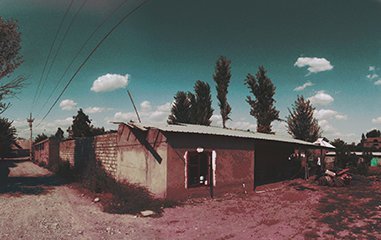09.10.2017: In regions of high seismic activity growing cities and populations result in an enhanced seismic hazard: The expected infrastructural damage as well as the potential loss of human life as the result of an earthquake are increasing. This is especially true for developing countries where non-earthquake resistant buildings further increase seismic hazard. In a case study scientists from the GFZ Centre for Early Warning Systems together with the Central Asian Institute for Applied Geosciences (CAIAG) now installed the first seismic network for earthquake monitoring and early warning in Kyrgyzstan and Kazakhstan.
Central Asia is one of the regions in the world with the highest seismic activity. Here, the Indian Plate pushes northwards into the Eurasian Plate with a speed of about four to five centimetres per year. Alongside this collision zone earthquakes occur again and again. So far, only few seismic stations were installed and a comprehensive earthquake monitoring was lacking. Further, no stations for strong ground-motion monitoring were available. This is why up to now earthquakes were neither monitored in detail nor were early warning systems installed for protecting the resident population. Extensive data base of use for scientific investigation of earthquake activity and seismic hazard is also missing.
In cooperation with the GFZ Central Asian Global Change Observatory (GCO) the initiative ACROSS „Advanced Remote Sensing – Ground Truth Demo and Test Facilities“ now installed the first digital seismic real-time network for Central Asia in Kyrgyzstan and Kazakhstan.
Only a few stations allow for earthquake early warning
The aim of the initiative was the development of a network design with minimal cost that would be applicable for other regions as well. The results are now published in the scientific journal Frontiers in Earth Science. The positioning of the monitoring stations were identified considering a permanent secure installation as well as a continuous power supply, and the availability of an infrastructure for the digital transmission of data in real-time. Only the real-time submission of seismic data allows for the operation of an early warning system.
Together with the Kyrgyzstan Ministry of Emergency Situations, 19 locations for strong-motion stations were installed, in close vicinity to the identified optimal locations of the network-design. In Bishkek, the capitol of Kyrgyzstan, cost-effective building and vertical sensors were installed and integrated within the network. Massimiliano Pitorre, researcher at the GCO: „The close cooperation with the end user of the system is a very important factor for a successful installation and operation of the network.”
The seismic activity of the underground was evaluated based on the software GFZ-Sentry, developed at the GFZ. The software determines critical ground motions with the potential of a high seismic hazard and informs the operator of the network who then decides to issue an early warning. Local authorities may then react on this warning.
So far the system is in a test phase but the team was already able to show that the minimum number of installed seismic stations allows for an early warning. The system is now further supported by the scientists for the purpose of further improvement and research. (ak)
Original study: Parolai, S., Boxberger, T., Pilz, M., Fleming, K., Haas, M., Pittore, M., Petrovic, B., Moldobekov, B., Zubovich, A., Lauterjung, J., 2017. Assessing earthquake early warning using sparse networks in developing countries: Case study of the Kyrgyz Republic. Frontiers in Earth Science. DOI: 10.3389/feart.2017.00074








![[Translate to English:] Torsten Sachs in front of a climate station on a field](/fileadmin/_processed_/3/9/csm__TorstenSachs_bearbeitet_GS_4a1365ef84.jpeg)

![[Translate to English:] left image flood at the Ahrtal: image from above, several houses are flooded; left image:: Heidi Kreibich;](/fileadmin/_processed_/4/4/csm_Bild2_9af0130e9f.png)



![[Translate to English:] Start der Vega Rakete](/fileadmin/_processed_/6/4/csm_20231201-kachel_Vega-VV23-launch_ESA-CNES-Arianespace_706716b68c.jpeg)









![[Translate to English:] Poster exhibition at the Brandenburg Hydrogen Day at the GFZ, some participants in the foreground](/fileadmin/_processed_/6/5/csm_Erster_Brandenburgischer_Wasserstofftag_GFZ_402fcec95e.jpeg)
![[Translate to English:] Group picture of the participants](/fileadmin/_processed_/9/4/csm_20231108_CAWa-Workshop-Tashkent_Gruppenbild_99ea779d8a.jpeg)

![[Translate to English:] [Translate to English:] Hörsaal](/fileadmin/_processed_/e/6/csm_H%C3%B6rsal_e21ac645fb.jpeg)


![[Translate to English:] The Delegations in the Historic Library on the Telegrafenberg. In the back there are from left to right, the Dutch Ambassador for Germany, Ronald van Roeden, the Dutch Minister for Education, Culture and Science, Robbert Dijkgraaf and the scientific director of the GFZ, Susanne Buiter.](/fileadmin/_processed_/d/b/csm_Kachel-2_9eba4b4212.jpeg)

